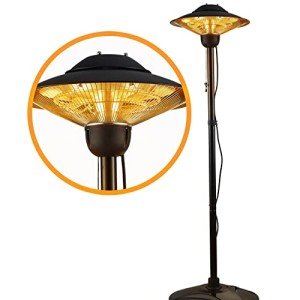The Top Reasons People Succeed In The Patio Heat Lamp Electric Industry

How to Choose a Patio Heat Lamp Electric
You have many options when it comes to heating up your patio. Unlike propane models that require refills electric heaters can provide instant heat by simply flicking an switch or pressing a button.
They also don't emit gases that could pose a health risk. Some models have adjustable temperature settings for varying distances.
outdoor heater for patio electric of Heater
With the right patio heater, you will be able to relax in your outdoor living spaces well into the night, and throughout the seasons. There are many kinds of heaters for patios, including freestanding propane and natural gas models, as well as ceiling or wall-mounted electric radiant heaters. Your choice will depend on the size of the space, power sources available and personal preference.
The majority of patio heaters use electricity, liquid or natural gas to generate heat. They emit heat through a combination convection heating and radiant heating. Their heat output is measured in watts, and can be converted to British thermal units (BTUs) for comparison. Certain models come with adjustable heat settings to give you more flexibility.
A patio heat lamp combines the burner on top of a pole with a perforated metal screen that reflect the flames and sends the heat downward to warm people, furniture and other objects. Some models have a reflector atop the burner, which can be silvered to cut down the amount of heat lost upwards.
Gas patio heaters are among the most popular heaters for patios. They can heat several tables quickly and evenly. These heaters are portable and run off the propane tank or plugged into your natural gas line, with the latter providing greater convenience and lower initial cost of installation, but they require ongoing expenses for fuel.
A growing number of homes are fitted with natural gas lines, which makes them the ideal option for those who prefer using gas-powered patio heaters. They're simple to install, but require a dedicated and functioning gas line in order to perform safely. There are portable natural gas heaters equipped with extension hoses which can aid in overcoming this issue, but they can be a risk of tripping and a fire risk when not in use.
Safety

Electric patio heaters can be used in enclosed areas since they allow heat to radiate upward and not outward. However, they're not intended to be used on an open roof. The heater must be installed at least 18" from the walls adjacent to it or 6" from the ceiling to prevent fire hazards.
The propane and gas patio heaters can only be installed in enclosed areas that have an enduring cover designed for outdoor use. These covers are usually made of fire-resistant canvas and come with the option of having a roof that is closed. outdoor electric heater patio of patio heaters are prone to safety concerns related to the flames and fumes they generate. They should be kept away from objects that ignite, such as curtains and chairs.
Follow the instructions and safety measures of the manufacturer when installing a patio heater or heat lamp. Choose a system that has UL and CSA safety certifications and be sure to read the owner's instructions thoroughly. Be extra cautious with pets and children and make sure the heater isn't near them when it's operating. Some free-standing patio heaters like EUROM come with a built-in tipping safety that shuts down the heater if it is tipped over.
If your patio heater is connected to a natural gas line, it is recommended to examine it regularly and be sure to have it tested by a licensed professional to identify leaks. If the line needs to be replaced, make sure to employ a licensed plumber. A professional is able to determine if the line needs to be routed through an underground pipe or not. A professional can also make sure that the heater in the patio is connected to an outlet that is GFCI-rated (ground fault circuit interrupter) to guard against electric fires and shocks.
Installation
The size of the patio heater is placed affects how much heat it will radiate into the space. The heater should be placed away from surfaces like plastic and wood that could deform. Depending on the heater model you can decide to place it on a wall or structure using standard mounting brackets. Some models have a soft start, which decreases the peak current in order to protect your circuits.
